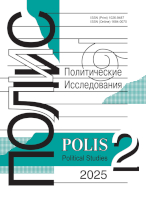Integrating the Humanities:
Semiotics or Memetics?
Fomin I.V.,
Cand. Sci. (Pol. Sci.), Associate Professor, National Research University Higher School of Economics; Researcher, Institute of Scientific Information for Social Sciences, RAS; Senior Research Associate, MGIMO University, fomin.i@gmail.com
elibrary_id: 638552 | ORCID: 0000-0003-4703-5262 | RESEARCHER_ID: R-8897-2016
DOI: 10.17976/jpps/2015.03.05
Fomin I.V. Integrating the Humanities: Semiotics or Memetics?. – Polis. Political Studies. 2015. No. 3. https://doi.org/10.17976/jpps/2015.03.05
The article explores semiotics and memetics as two concepts that both seek to play the role of transdisciplinary integrators for humanities. Semiotics with its theoretical and methodological concepts allows to study not only texts in natural languages, but any pieces of semiotic reality. So in prospect it can play in the humanities the role that is similar to that played by mathematics in natural science. However, nowadays semiotic research methods exist only as number of stand-alone methods dispersed in various disciplines, traditions and fields of study. In order to come to function as an integrative methodology semiotic concepts that are in use should be properly reflected from this transdisciplinary point of view. The concept of sign, which is a basic concept of semiotics, is not an exclusive notion that can become an elementary category for the analysis of cultural reality. In social sciences and humanities one can find a whole range of concepts that try to grasp and represent some abstract elemental forms in which culture is brought to existence, developed and reproduced. In this range one can find words like myth, idea, image etc. The meaning of those concepts in some aspects can seem rather similar, but for some reason they exist parallelly and always leave an impression that there is some difference between them that does not allow them to be converged. The concept of meme is one of the newest ones in this set of notions. According to memetics (study of memes), any cultural information is composed of memes, in the same way as biotic information is composed of genes. But is memetics capable of going beyond this primary vision? Can it be a functional theoretical and analytical tool? Can it be complemented with the concepts of semiotics? What are the strengths and weaknesses of these two theoretical and methodological frameworks?
See also:
Editorial Introduction,
Introduction to the rubric. – Polis. Political Studies. 2015. No3
Information,
Potential of Socio-Humanities and Problems of the Development of Modern Russian Society 181. – Polis. Political Studies. 2003. No4
Torkunov A.V.,
Challenges to Social and Human Sciences in Russia. – Polis. Political Studies. 2018. No5
Patzelt W.J.,
Morphology and Casuality. – Polis. Political Studies. 2015. No3
Ilyin M.V., Nechayev V.D.,
Challenges and prospects of study of the Greater Mediterranean. – Polis. Political Studies. 2022. No3





.jpg)






 print
print
.jpg)
.jpg)